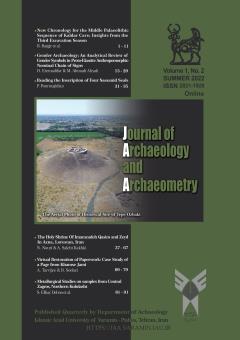Gender Archaeology; An Analytical Review of Gender Symbols in Proto-Elamite Anthropomorphic Nominal Chain of Signs
محورهای موضوعی : ArchaeologyDonya Etemadifar 1 , Masoud Ahmadi Afzadi 2
1 - Department of Archaeology, Faculty of Humanites, Islamic Azad University, Tehran Branch, Tehran, Iran
2 - Department of History, Islamic Azad University, Tehran North Branch, Tehran, Iran
کلید واژه: gender, Syllabic structure, Proto-Elamite, Tablets of Susa,
چکیده مقاله :
Gender archaeology, the study of gender differences between men and women throughout history, is a significant subject that has evolved into a proper, prominent science in recent decades. Proto-Elamite is among the periods that give us great information regarding the status of genders. The abundance of tablets found from this period is among the oldest middle-eastern written scripts. Many of these are about paying wages to male and female laborers for manufacturing and stockbreeding jobs. Studying these texts provides essential information regarding the status of Iranian Plateau’s women at the end of the fourth millennium B.C. M388 sign is one of the most significant gender signs known. It probably symbolizes a man or a particular social class in proto-Elamite texts. It’s also been used before signs that might show names written using a phonetical structure. M124 is the opposite sign. It was probably considered a female gender sign. It has been used in some tablets or at the beginning of a series of phonetic signs (names). This research attempts to reconstruct two different signs at the beginning of the name sign-series. These signs probably assign gender to the names. Authors read 1500 tablets in Susa. Two hundred ninety-five of these tablets begin with M124 or M388 signs. There are more than 100 phonetic signs. The chances of 295 names being similar are slim. This strengthens our gender-specification hypotheses that M124 and M388 are gender symbols in the name sign-series.


